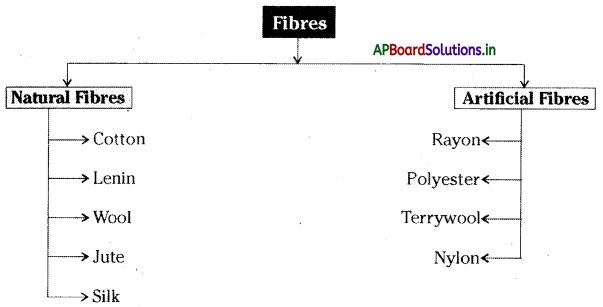Students can go through AP State Board 6th Class Science Notes Chapter 8 How Fabrics are Made to understand and remember the concept easily.
AP State Board Syllabus 6th Class Science Notes Chapter 8 How Fabrics are Made
→ The tiny strands like structures are called fibers.
→ The fibers are converted into yarn. Yarn is woven to make a fabric.
→ The fibers derived from plants and animals are called natural fibers. Ex: Cotton, Wool, Jute, Silk.
→ The fibers derived from chemicals are called artificial fibers. Ex: – Polyster, Terlin, Nylon, Rayon.
→ The process of removing seeds from the cotton ball is called Ginning.
→ Making yarn from the fiber is call spinning.
→ Making fabric from yarn is weaving.
→ The weaving is done on specialized equipment “Loom”
→ In looms, there are two types, the Handloom and the Powerloom.
→ The coarse fabric can be used for making gunny bags but not for making clothes.
→ If we burn artificial fiber it gives a pungent smell.
→ The artificial fiber polyester is derived from petroleum.
![]()
→ Polythene bags takes much time to decompose in the soil.
→ We use fabric as a Shield to protect ourselves from different weather conditions.
→ Cloths can also be a symbol of beauty and status.
→ Jute fiber is obtaining from the stem of the Jute plant. ,
→ Calico is a type of fabric using bookbinding and making banners.
→ In ancient days human beings used leaves and skins of animals as clothes. Clothes were also made from metal.
→ West Bengal alone accounts for over 50% of raw Jute production.
→ 80% of women constitute work in the Coir industry.
→ Brown Coir is used in brushes, doormats, mattresses, and for making sacks.
→ To protect our environment, we should use cloth bags instead of polythene bags.
→ Fibers: A thread-like structure formed from plant or artificial material
→ Fabrics: A type of cloth
→ Coarse fabric: Rough fabric
→ Natural fibers: The fibers derived from plants or animals
→ Artificial fibers: The fibers made of chemicals
![]()
→ Ginning: Separation of seeds from a cotton boll
→ SpInning: Making yarn from fiber
→ Yarn: Thethreadsinfahricareyarn
→ Weaving: Yarn arranging together to make fiber
→ Handloom: A cloth made by hand.
→ Powerloom: A loom powered by water, steam, or electricity rather than by hand
→ Loom: An equipment that weaves the threads into cloth
→ Soak: Keeping material in water for few days
→ Coir: Fibers deriving from coconut fruits
→ Strand: A thin thread of something 1m mense to put something or someone for completely underwater or surface of the water
→ Enrich: To improve the quality of something by adding something else
→ Calico: A type of cloth using in bookbinding
→ Combing: Arrangíng the fibers In lengthwise,
→ Dying: Addingcolourtofibres
→ Armor: The metal jacket using by kings and the army.

→ The material used for making school bags is also a kind of fabric. Fabrics are not only used for making clothes; they are also used in making banners, flags, shoes, curtains, bookbinding, etc. Calico is a type of fabric used in bookbinding.
![]()
→ Human beings in ancient times used leaves and skins of animals as clothes. Clothes were also made from metal. Warriors used to wear metal jackets during wars. You can see clothes like these in historical museums or in television shows.

→ In some parts of our state, cotton is widely grown. To pick up matured cotton boils from cotton plants, children work in fields as child labor. Some voluntary organizations along with the government are working to eradicate child labor. Think, why children are forced into labor? Give your own solutions to this problem.
→ In India, the jute crop is majorly grown in 7 states -West Bengal, Assam, Odisha, Bihar, Uttar Pradesh, Tripura, and Meghalaya. West Bengal alone accounts for over 50% of raw jute production.
→ We all use polythene bags for different purposes. Polythene is very difficult to decompose. To protect our environment, we should use cloth bags instead of polythene bags.
